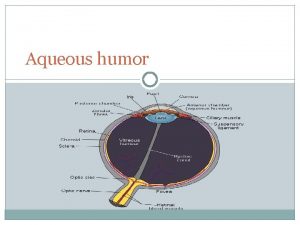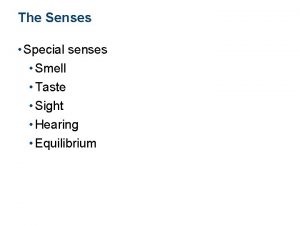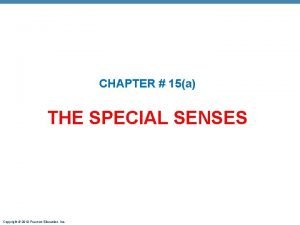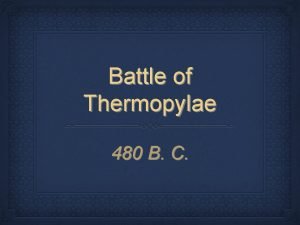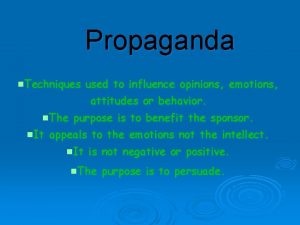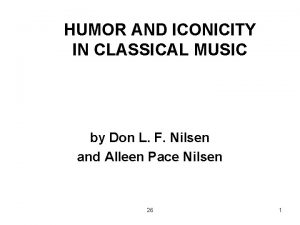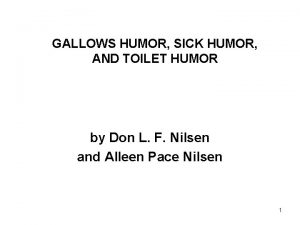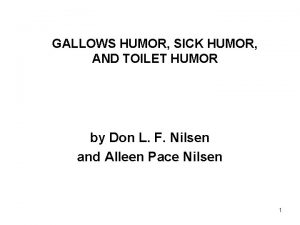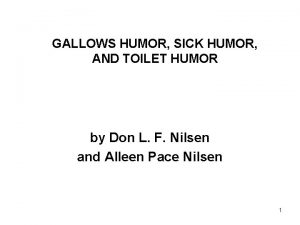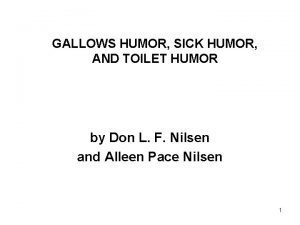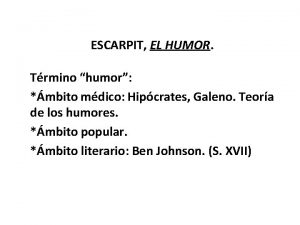Aqueous humor The aqueous is the thin watery
















- Slides: 16

Aqueous humor

�The aqueous is the thin, watery fluid that fills the space between the cornea and the iris (anterior chamber). �It is continually produced by the ciliary body, the part of the eye that lies just behind the iris. �This fluid nourishes the cornea and the lens and gives the front of the eye its form and shape


Function �Maintains the intraocular pressure. �Provides nutrition (e. g. amino acids and glucose). �Carries away waste products. �May serve to transport ascorbate in the anterior segment to act as an anti-oxidant agent. * �Presence of immunoglobulins indicate a role in immune response to defend against pathogens

* Vitamin C, being a water soluble antioxidant, protects body fluids such as saliva, blood, lymph, intra and intercellular fluids, and those fluids that surround the lens of the eye. A recent study headed by Dr. Allen Taylor of Tufts University found that women who had daily intakes of 362 mg or more of vitamin C had a 57 percent lower risk of developing cataracts by age 60 than women whose daily intakes were less than 140 mg. In older women and men, high intakes of vitamin C have been shown to delay the onset of cataract and reduce its severity

Composition �The fluid is essentially the same as blood plasma although with less protein. �Water: 99% �Ions: HCO 3 -, buffers metabolic acids; Cl-, preserves electric neutrality; Na+; K+; Ca 2+; PO 43 -. �Proteins: albumin, β-globulins. . �Ascorbate: anti-oxidative, protects against UV. �Glucose �Lactate: produced by metabolism of anaerobic structures of the eye. �Amino acids: transported by ciliary epithelial cells.

Flow of Aqueous Humor The fluid produced by the eye’s ciliary body flows out freely. Aqueous humor flows from the ciliary body into the anterior chamber, out through a spongy tissue at the front of the eye called the trabecular meshwork and into a drainage canal

Disorders �Glaucoma is a condition characterized by increased intraocular pressure (pressure within the eye) either through increased production or decreased outflow of aqueous humor. � Uncontrolled glaucoma typically leads to visual field loss and ultimately blindness

Vitreous Humor


�The vitreous humor is the clear gel that fills the space between the lens and the retina of the eyeball of humans and other vertebrates. �The vitreous is the transparent, colorless, gelatinous mass that fills the space between the lens of the eye and the retina lining the back of the eye �It is produced by certain retinal cells.

�It contains very few cells (mostly phagocytes which remove unwanted cellular debris, as well as the hyalocytes of Balazs, which produce the hyaluronic acid). �No blood vessels, and 99% of its volume is water with salts, sugars, and a network of collagen with the muco-polysaccharide hyaluronic acid.

�The collagen fibres of the vitreous are held apart by electrical charges. With ageing, these charges tend to reduce, and the fibres may clump together. �Similarly, the gel may liquefy, a condition known as syneresis, allowing cells and other organic clusters to float freely within the vitreous humour. These allow floaters which are perceived in the visual field as spots or fibrous strands. Floaters are generally harmless, but the sudden onset of recurring floaters may signify a posterior vitreous detachment (PVD) or other diseases of the eye.



 Watery humour
Watery humour Humor vítreo e humor aquoso
Humor vítreo e humor aquoso Otolithic membrane
Otolithic membrane Eye diagram pearson
Eye diagram pearson Vestibulocochlear
Vestibulocochlear What type of irony
What type of irony Ouderen humor
Ouderen humor Database humor
Database humor Static irony
Static irony Structural irony in pride and prejudice
Structural irony in pride and prejudice Thermopylae a soldier's humor
Thermopylae a soldier's humor Self deprecating humor
Self deprecating humor Contos de humor
Contos de humor Types of comedy
Types of comedy A catchword or phrase loaded with emotion
A catchword or phrase loaded with emotion Humor in classical music
Humor in classical music Analyserende artikel opbygning
Analyserende artikel opbygning
